With a state nickname like “Land of 10,000 Lakes,” it shouldn’t come as any surprise that Minnesota is also a land of ducks!
Minnesota is home to more than 14,000 lakes. In and around those lakes, you’re going to find a variety of ducks. Some stick around all year, while others are only in Minnesota in the summer or winter.
In addition to living on lakes, ducks also live alongside rivers and in wetlands, marshes, agricultural ponds, public parks, neighborhoods, and so many more areas.
Learning to identify ducks is a rewarding and interesting hobby! While some birders focus mostly on songbirds, and others on birds of prey, there are plenty of birders who love to spot waterfowl!
There are several types of waterfowl in Minnesota, including ducks and geese. Let’s take a look at the 21 different kinds of ducks you can find in Minnesota.
Perhaps you can start putting together a list of ducks that you have spotted in the Land of 10,000 Lakes!
First Things First: Is That a Dabbling Duck or a Diving Duck?
As you look at our list, you might notice that there is a parenthetical right next to the name of each duck, identifying it as either a dabbling duck or a diving duck.
What’s the difference?
Dabbling and diving ducks aren’t differentiated because of their appearance, the sounds they make, or what kind of water they live on. Instead, their label comes from their behavior on the water.
Dabbling ducks tip themselves over and submerge their heads underwater as they look for food from the bottom of the lake or river. Their little tails can be seen from the surface, sticking up out of the water.
Diving ducks, on the other hand, submerge themselves entirely and dive under the surface to find the plants and creatures that make up their diet. When they go underwater, they disappear entirely and come up after some seconds or even a full minute!
We’ve identified each duck in our list as a dabbling or diving duck because it’s a useful identification tool! If the duck disappears under the water, it can only be one of the ducks listed as a diver. If you see its tail bobbing on the surface, it can only be a dabbling duck.
Ready to learn about the ducks of Minnesota? Let’s go!
American Black Duck (Dabbling Duck)
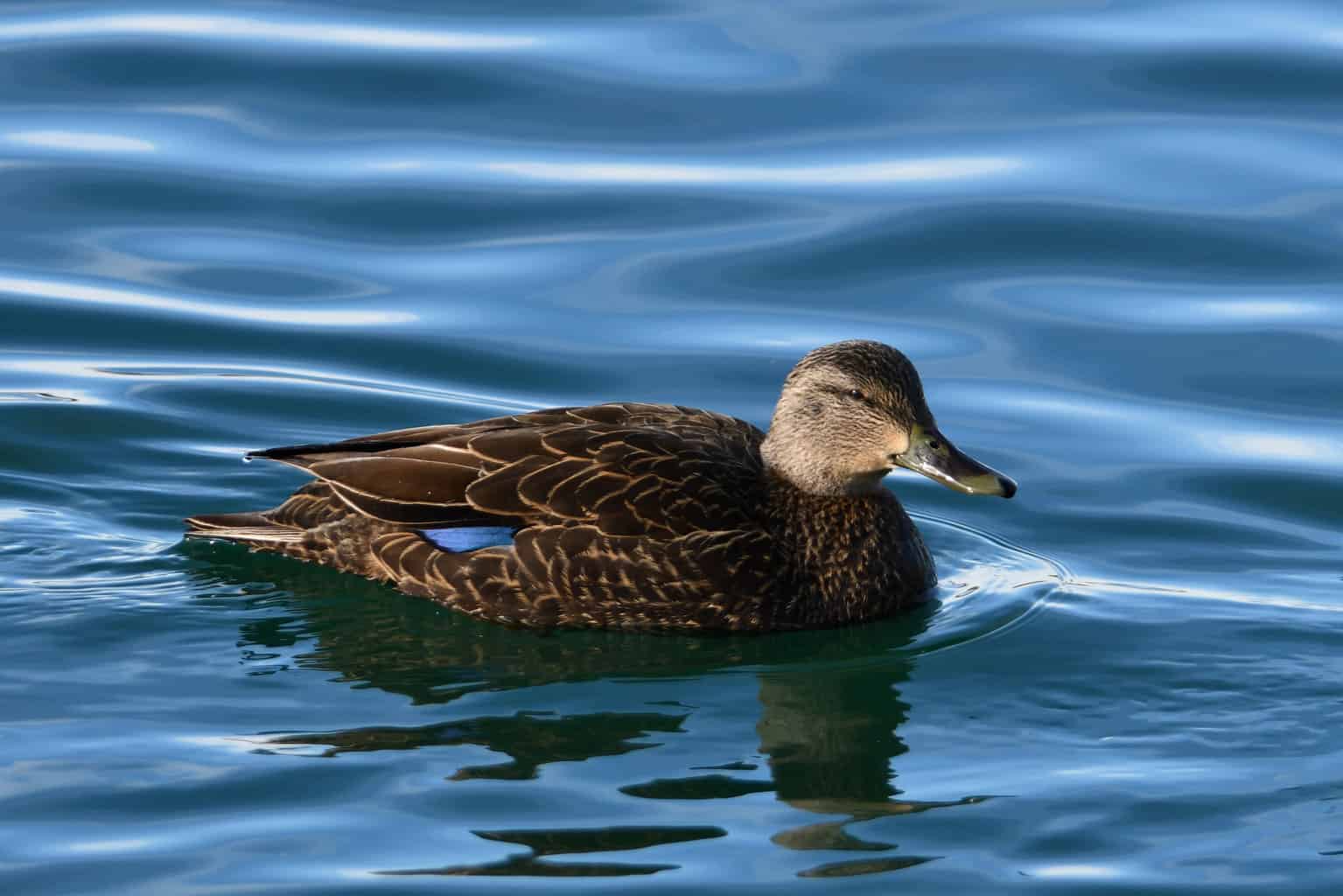
- Scientific Name: Anas rubripes
- Length: 21.3-23.2 inches
- Weight: 25.4-57.9 ounces
- Wingspan: 34.6-37.4 inches
Because American Black Ducks are very dark brown, they have been mistaken for being black in color. That slight misrepresentation is where their name comes from.
The male’s head is a lighter brown than the rest of his body. Females and males are similar in appearance, but her whole body is lighter, and her bill is olive green compared to his yellowish bill.
Both sexes have an iridescent, blueish-purple speculum. The speculum is a colorful band on a duck’s secondary feathers, and it is often only visible in flight.
Minnesota is the far western edge of the American Black Duck’s range. They can be found in the boreal forests of the north, often in bogs, sedge meadows, and wild rice beds.
American Wigeon (Dabbling Duck)

- Scientific Name: Mareca americana
- Length: Up to 14 inches
- Weight: About 2.25 pounds
- Wingspan: 34 inches
You can spot the male American Wigeon by his iridescent green band that runs from his eyes to the back of his head. He also has a wide, vibrant, white crown on his head. The female has a brown body and a gray head with a brown stippling pattern.
Both males and females have a black-tipped blue bill. They use their strong, thick bill to pull plants from the riverbed.
American Wigeons aren’t common in Minnesota, but there are at least some in the state during the migration season, and a few breed in the far north of the state. You’re also likely to find them in the winter on the Lower Mississippi River.
They breed in shallow water such as marshes, estuaries, and ponds, but they spend the winter around deep lakes.
Blue-Winged Teal (Dabbling Duck)
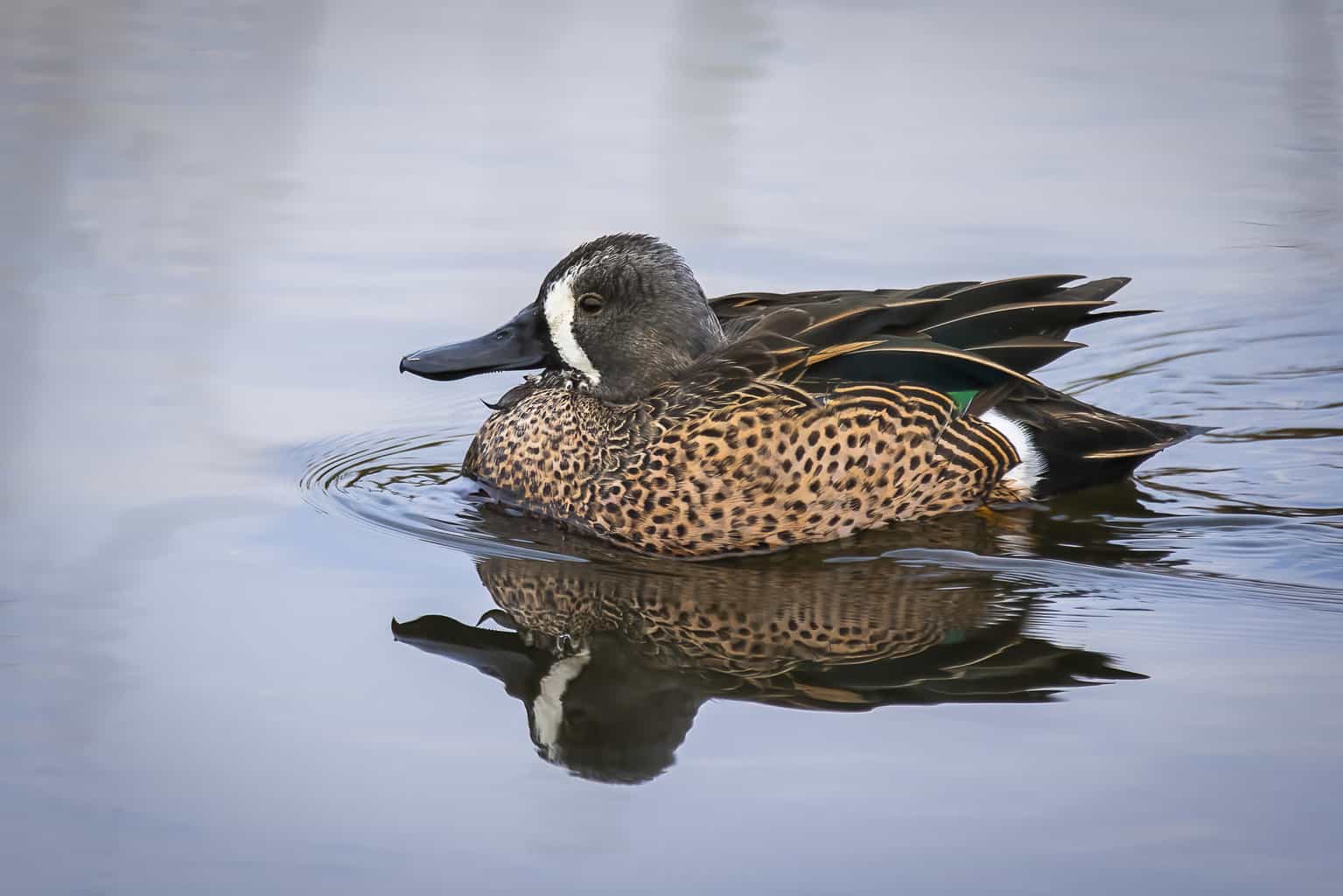
- Scientific Name: Anas discors
- Length: 16 inches
- Weight: 13 ounces
- Wingspan: 23 inches
Many kinds of ducks have a different appearance in the breeding season than they do the rest of the year. Male Blue-Winged Teals are a great example of this phenomenon.
In the summer, the male Blue-Winged Teal Duck is mostly brown. He has a gray-blue head and a speckled breast, as well as a white patch near his tail and a white stripe down his face.
During the rest of the year, his coloring is much lighter. Like females and juveniles, he will have a plain brown body with a blue patch on the wing that can only be seen when he’s flying.
Minnesota is located right in the heart of the Blue-Winged Teal Duck’s breeding range.
These ducks are less comfortable in extremely cold temperatures, so they migrate out of Minnesota before most other duck species. They usually leave by late September and return in late April or early May.
Bufflehead (Diving Duck)
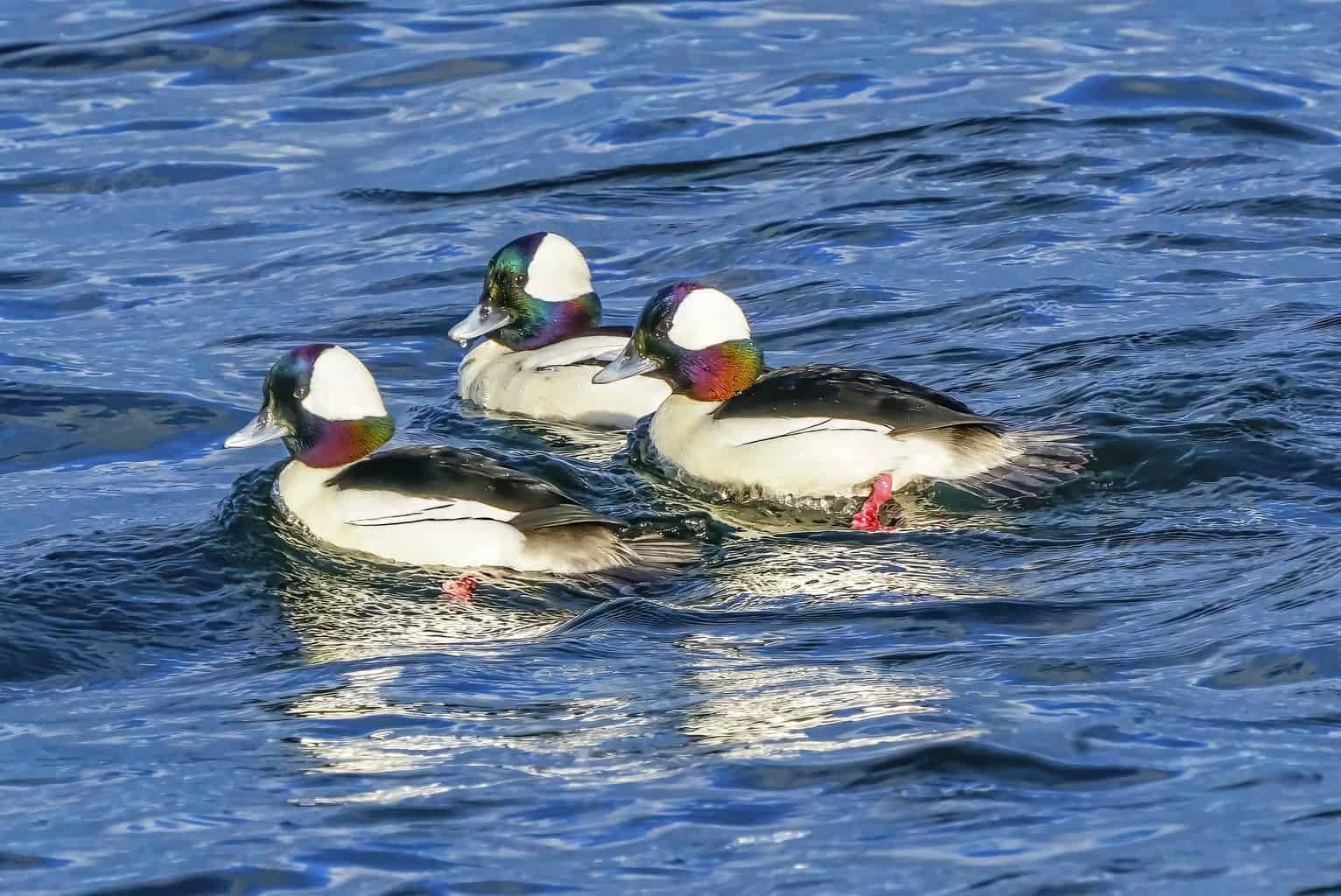
- Scientific Name: Bucephala albeola
- Length: 13-16 inches
- Weight: 11-16 ounces
- Wingspan: 22 inches
The unique name “Bufflehead” is derived from “buffalo-head.” It comes from the unusual and large, puffy shape of this duck’s head. This is an especially noticeable head because it’s so large for such a small body!
Buffleheads, in fact, are North America’s smallest diving duck. They are migratory ducks and spend the winter throughout most of the US. They are regular inhabitants of Minnesota during the breeding season and through their migration. They are especially likely to be seen on Lake Superior.
The male Bufflehead is white-bodied with a black back and a metallic green and purple head. He has a large white patch on the back of his head, which creates a color-block appearance.
Females and juvenile males have a much more muted appearance of brownish-gray. They have a large, white oval on their cheeks.
Canvasback (Diving Duck)
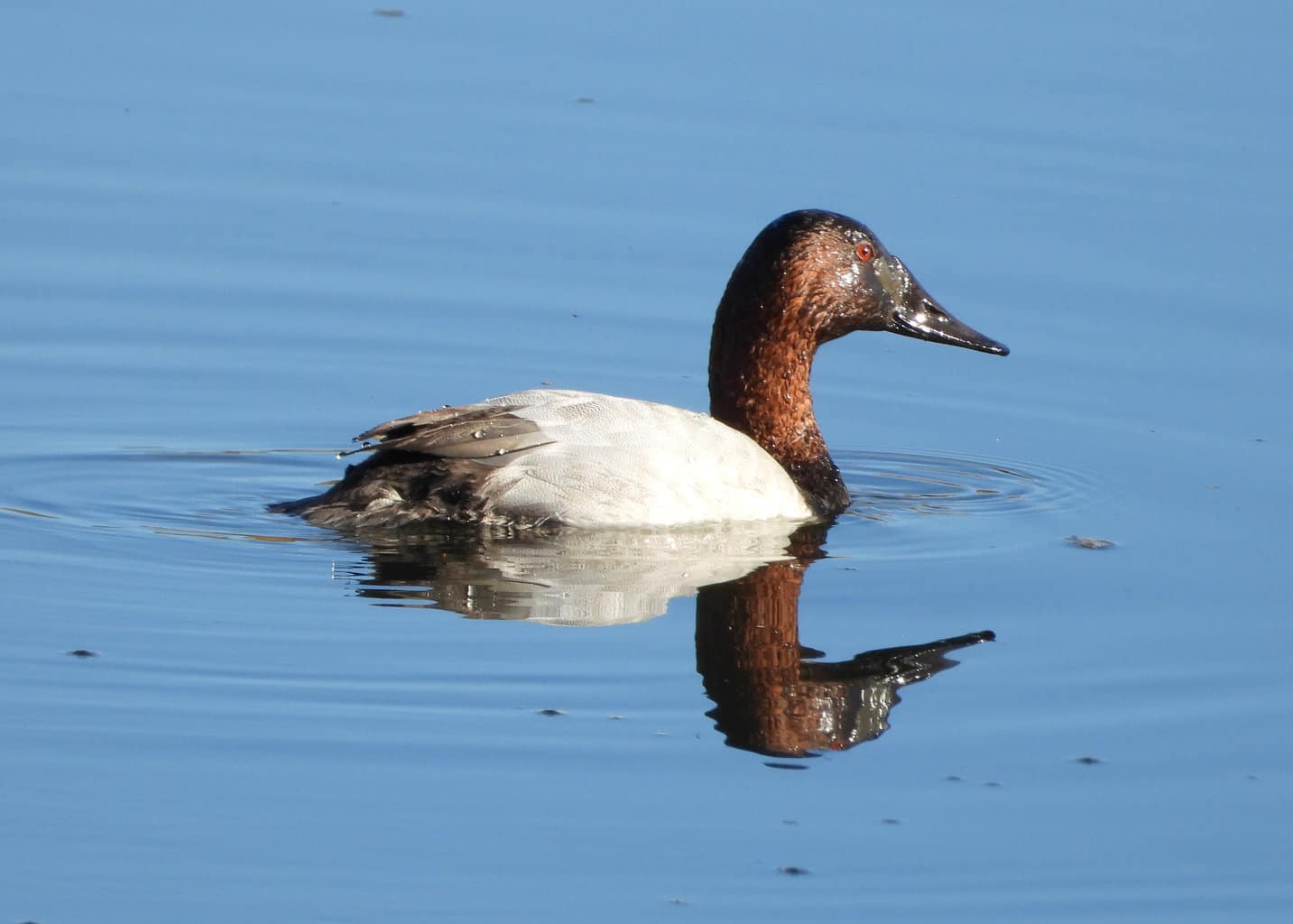
- Scientific Name: Aythya valisineria
- Length: 13-16 inches
- Weight: Up to 2.5 pounds
- Wingspan: Up to 3 feet
The western edge of Minnesota sees Canvasback ducks during the breeding season, but otherwise, they don’t visit the rest of the state. They arrive within the first week of May and lay about eight eggs in each clutch.
Canvasbacks are large and fast.
They can fly up to 72 miles per hour, which is 30 miles per hour faster than the average duck.
They have thick necks, big heads, and long bills. Males and females are black, white, and chestnut brown, but the male’s coloring is darker. Males also have red eyes, whereas females’ eyes are dark brown.
Canvasbacks commonly practice brood parasitism, where they lay their eggs in other birds’ nests. Typically, Canvasbacks choose other Canvasback nests for their eggs, but they’ll also lay eggs in Ruddy and Redhead duck nests.
The arrangement goes two ways, though. Canvasbacks will raise the young of Ruddy and Redhead ducks that hatch in their own nests.
Cinnamon Teal (Dabbling Duck)
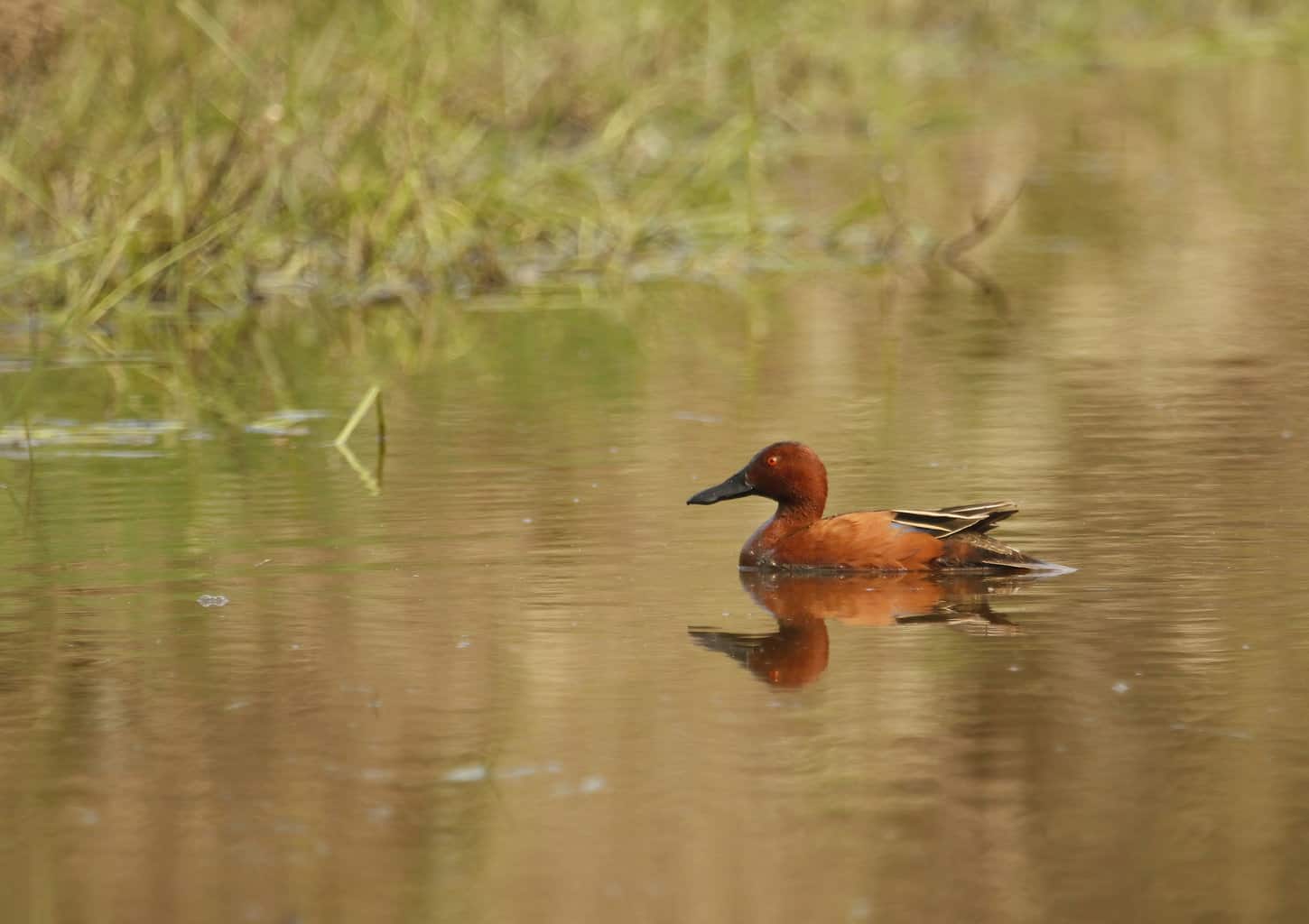
- Scientific Name: Spatula cyanoptera
- Length: 11 inches
- Weight: 12.6-18.2 ounces
- Wingspan: 25 inches
During the breeding season, male Cinnamon Teal Ducks are stunning! Their heads, necks, breasts, and shoulders are a deep, rusty brown. Primary feathers are brown and black, and secondary feathers are green.
Juveniles, non-breeding males, and females are coarsely mottled in dark brown. All Cinnamon Teal adults have a shoulder patch in sky blue.
Instead of dwelling in cavities left behind by other birds, which is what many other ducks do, Cinnamon Teal Ducks build their nests right in the aquatic grasses that grow in the wetlands.
They conceal their nests under dead leaves, branches, and other vegetation. The female is able to build tunnels under these grasses to access her nest!
Cinnamon Teal Ducks are rare in Minnesota – to the point that it was a newsworthy event when one was spotted on Prior Lake in 2017!
Common Goldeneye (Diving Duck)
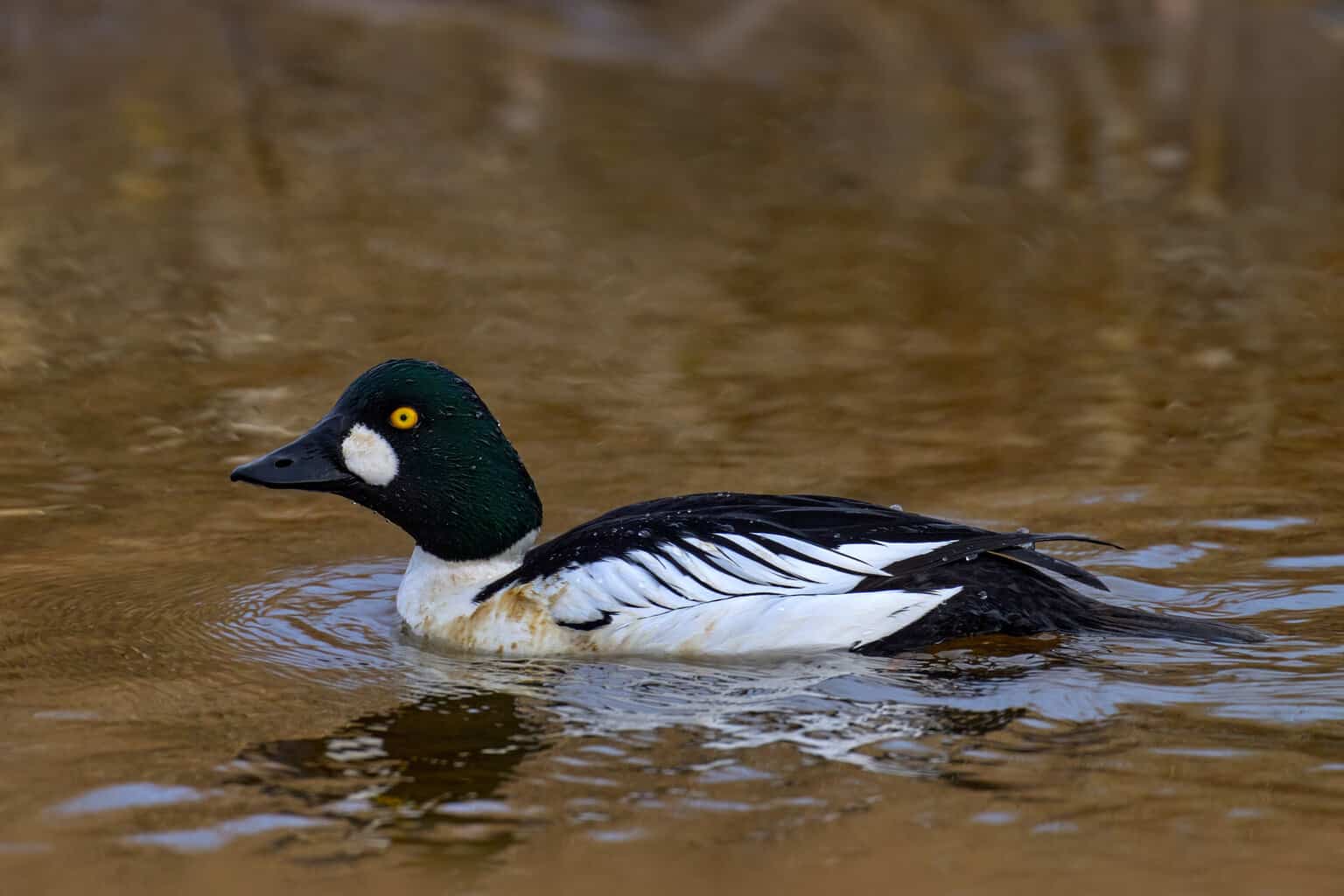
- Scientific Name: Bucephala Clangula
- Length: 16-20 inches
- Weight: Approximately 1.8 pounds
- Wingspan: 30.3-32.7 inches
The Common Goldeneye gets its name from its flashy yellow eyes. Other than their shared eye color, female and breeding male Goldeneyes have few similarities.
The female has a gray body and brown head, whereas the male is very dark green and white. He also has a small white patch on his cheek, which she doesn’t have.
Both males and females have a white patch on their wings. In the winter, males lose their signature coloring and take on the same basic appearance as a female.
Here’s something interesting about Goldeneyes: the females aren’t very attentive mothers. It’s not uncommon for them to abandon their ducklings soon after hatching, which leaves the babies scrambling to find another female duck to take them in.
Female Goldeneyes are also prone to fighting with other ducks, which can cause their ducklings to scatter and hide…and then be unable to find their mother again! When a new mother raises her own ducklings along with these newcomers that she didn’t hatch herself, the collection of babies is called a creche.
Common Goldeneyes breed throughout most of Canada. Their winter territories include most of the US, excluding southern Texas and a few parts of the southeast.
In Minnesota, they spend the breeding season in marshes, ponds, rivers, and lakes. During migration, which occurs from February to May and October to December, they spend time on bigger bodies of water, including large lakes, ponds, and rivers.
Common Merganser (Diving Duck)
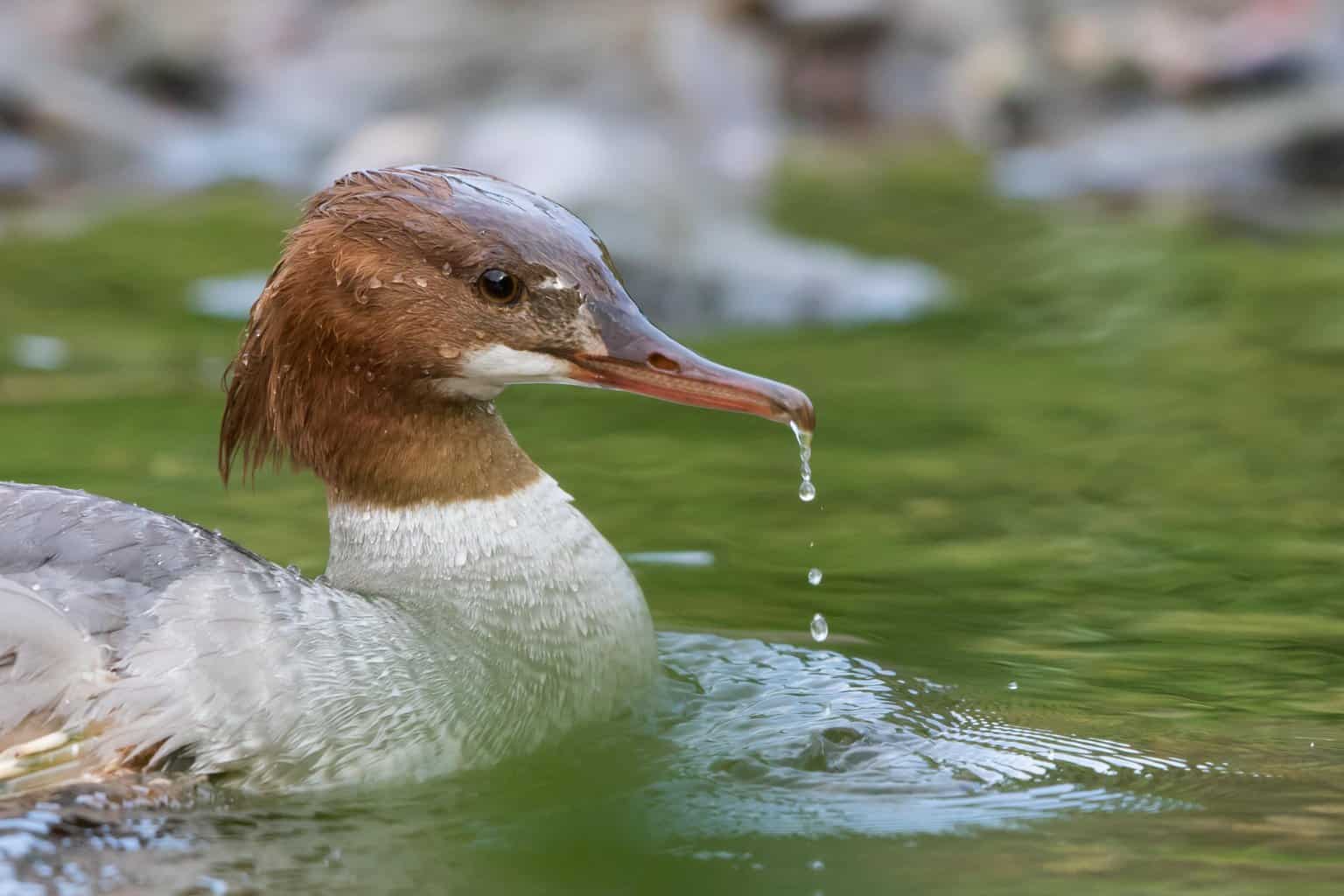
- Scientific name: Mergus merganser
- Length: 21.3-27.9 inches
- Weight: 31.8-76.2 ounces
- Wingspan: 33.9 inches
Common Mergansers are common migrants in Minnesota but rarely stay through the breeding season.
The breeding season male has a metallic green head, white body, and black back. His red bill has a black tip on the end. At the end of summer, non-breeding males take on the appearance of the female: cinnamon-colored head, gray body, and a sharp contrasting line dividing the neck and body.
Males begin to return to their breeding season appearance by early winter.
Common Mergansers are excellent fishers. While this works in their favor when it comes to finding food, it is a bit of a disadvantage, too.
That’s because their skills have been noticed by other birds, including gulls and bald eagles, who will follow them around to steal their fish!
Gadwall (Dabbling Duck)
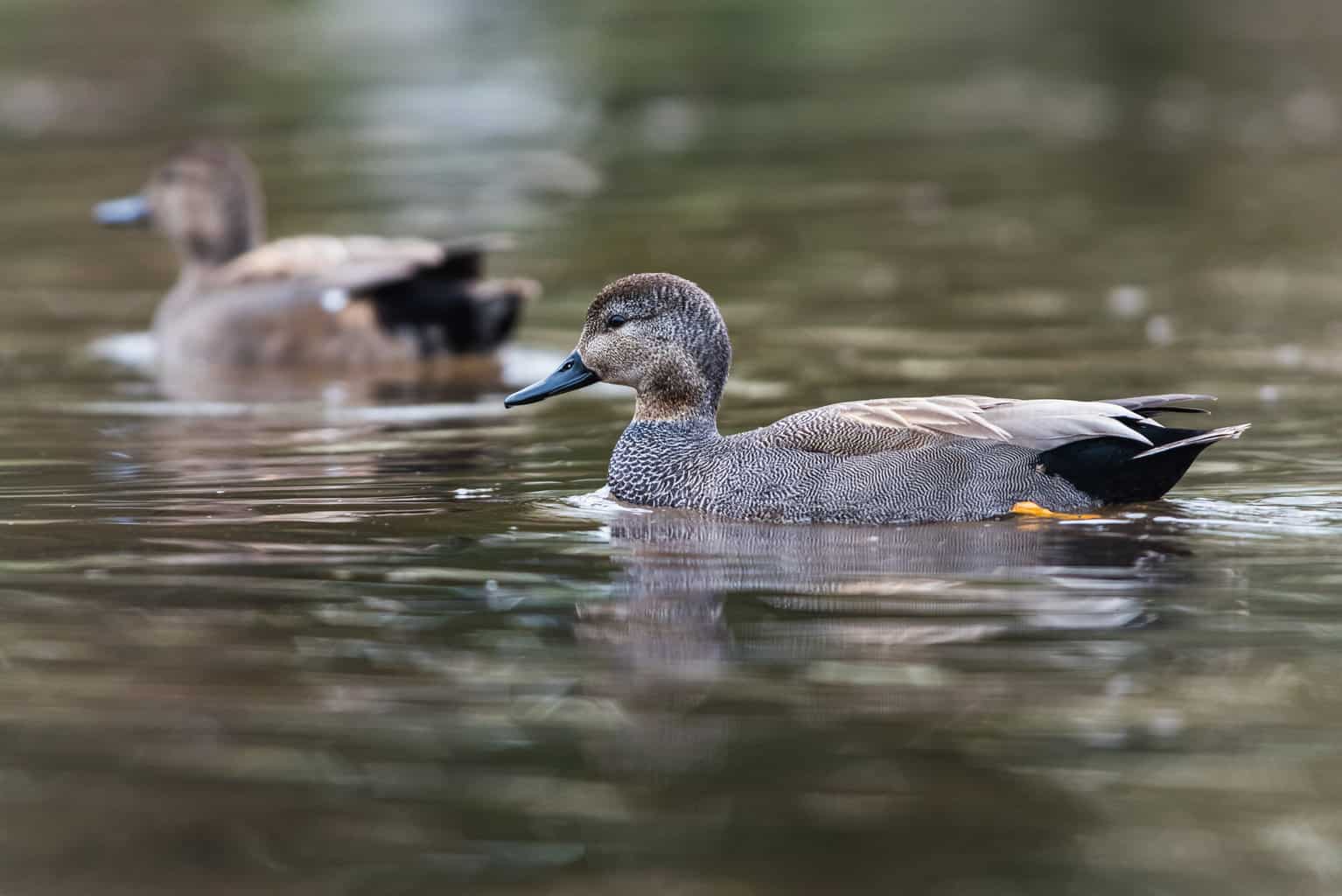
- Scientific Name: Mareca strepera
- Length: 18.1-22.4 inches
- Weight: 17.6-44.1 ounces
- Wingspan: 33.1 inches
Gadwalls are common in Minnesota during the breeding and migration seasons, although they don’t travel farther than the west-central and northwestern parts of the state. The only exception to this is that there are a few spots in the southern half of the state with enough open water for them to gather in the winter.
They nest on the ground and feed on aquatic plants.
Gadwalls have square-shaped heads, thin necks, and thin bills. Neither males nor females are very flashy; males are gray and green in color, and females are off-white and light brown. They both have a white wing patch that is visible while on the water.
The Gadwall is also a notorious thief! They wait for other ducks to resurface after diving, then steal their favorite food right from their bill!
Greater Scaup (Diving Duck)
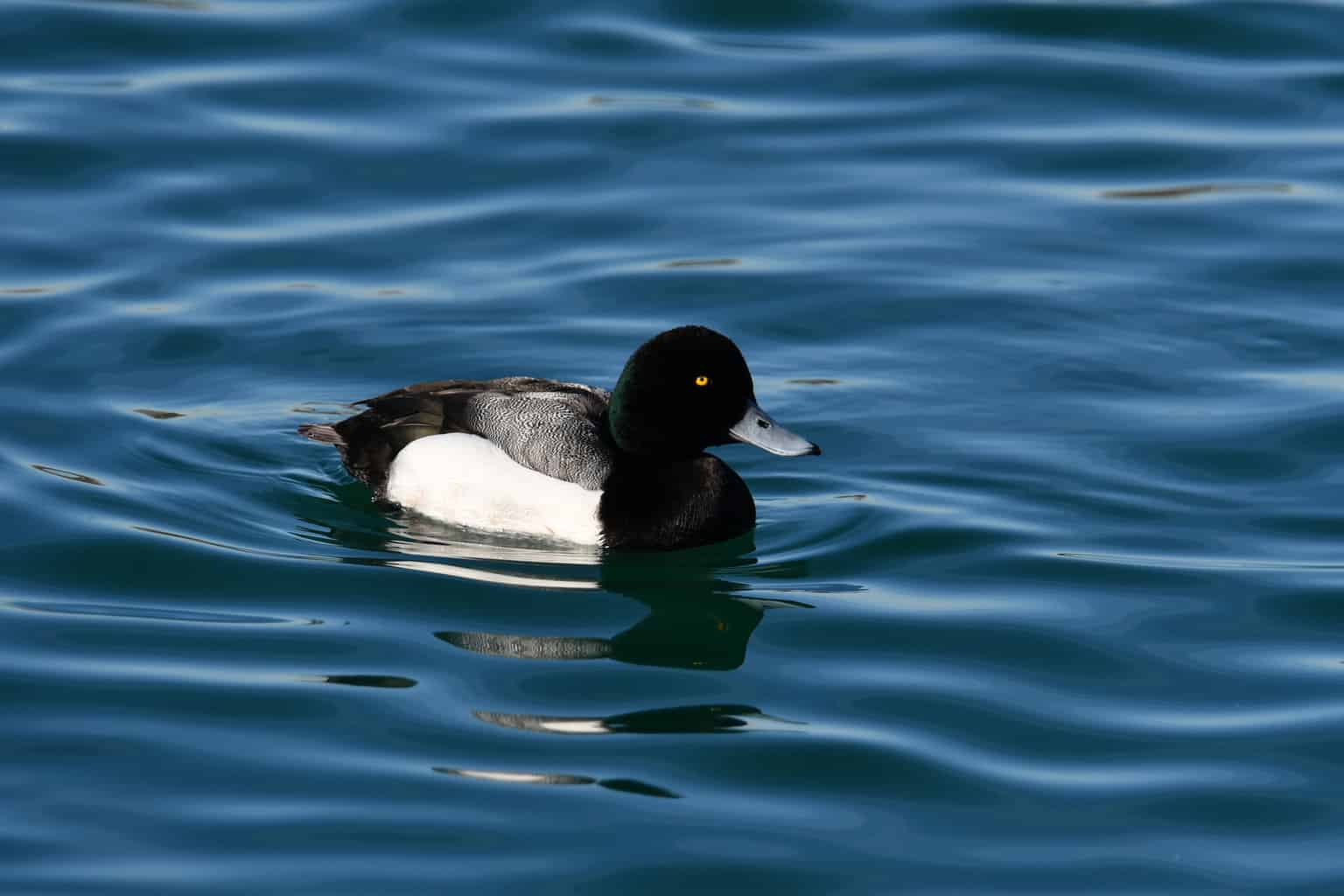
- Scientific Name: Aythya marila
- Length: 15-22 inches
- Weight: 1.5-2.9 pounds
- Wingspan: 28-33 inches
The Greater Scaup is also known as the Bluebill. The reasons are pretty evident: the male’s bill is slate-blue. The female’s bill is much darker, but still has a hint of blue.
Breeding-season males are dark green. Females, juveniles, and non-breeding males are grayish-brown and almost-black heads.
For the most part, Minnesota only sees Greater Scaup during their migration. They travel through the state between late March and early June for their breeding season, then make their way back between early October and early December.
Their habitat includes marshes, lakes, and reservoirs. They are typically spotted far from the shore. Interestingly, they are the only circumpolar diving duck in the world, inhabiting North America and Europe along the North Pole.
Green-Winged Teal (Dabbling Duck)
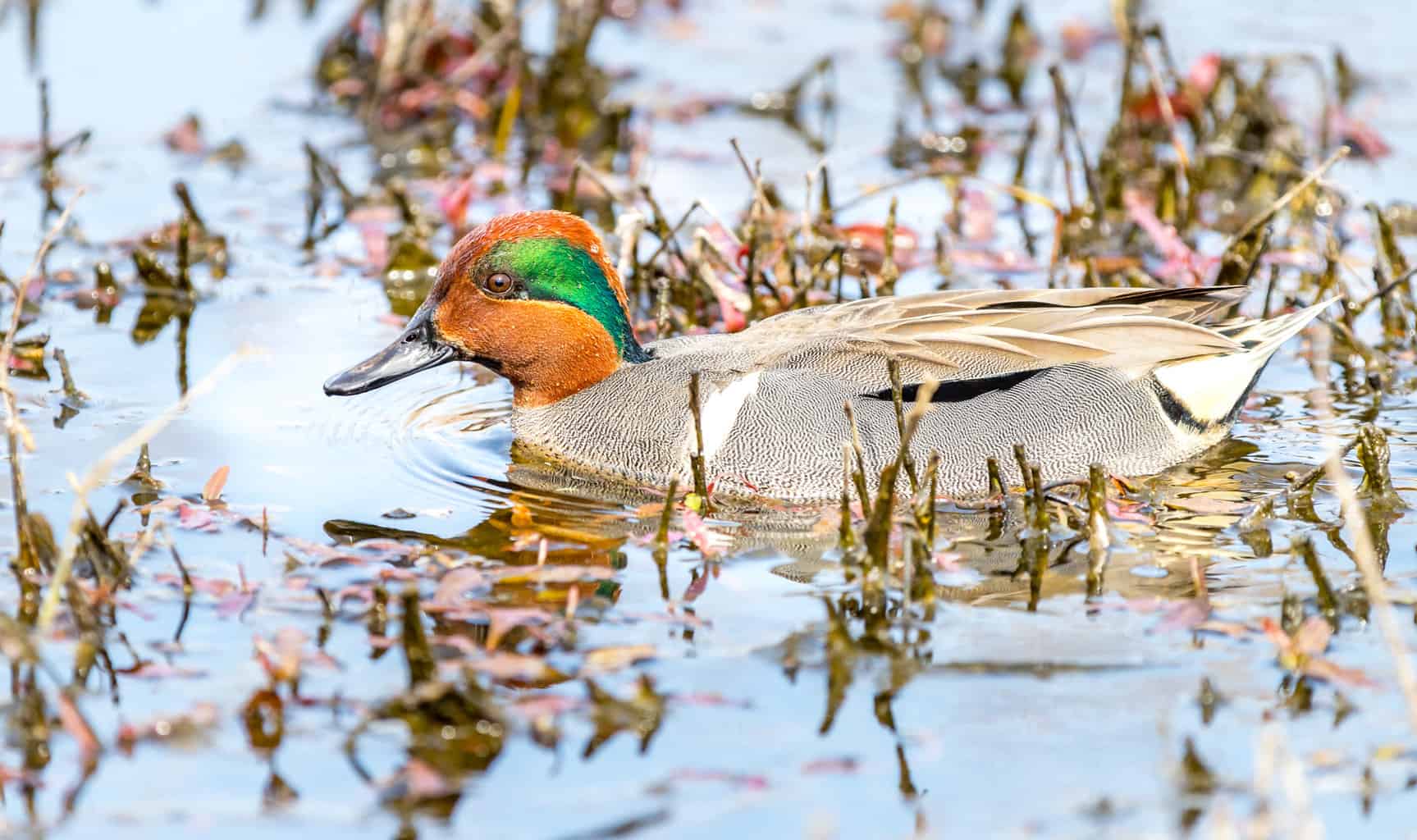
- Scientific Name: Anas carolinensis
- Length: 12.2-15.3 inches
- Weight: 4.9-17.6 ounces
- Wingspan: 20.5-23.2 inches
Green-Winged Teal Ducks aren’t exclusive to North America. They are also found in Iceland, Greenland, and throughout Northern Europe.
They travel through Minnesota as they migrate between their summer breeding territory in Canada and their winter habitats across the southern and western United States.
A male Green-Winged Teal Duck can be identified by the iridescent green stripe that runs from the back of his eyes to the back of his head, which is coppery-brown. Females have subtle coloring, mostly brown with lighter brown barring.
Both sexes have an iridescent green speculum.
As the smallest dabbling ducks in North America, they live along a variety of wetlands, including marshes, estuaries, rivers, and flooded agricultural ponds. They are known for gathering and traveling in massive groups. During the breeding season, it’s not uncommon for them to gather on lakes in groups of up to 50,000 individuals!
Hooded Merganser (Diving Duck)
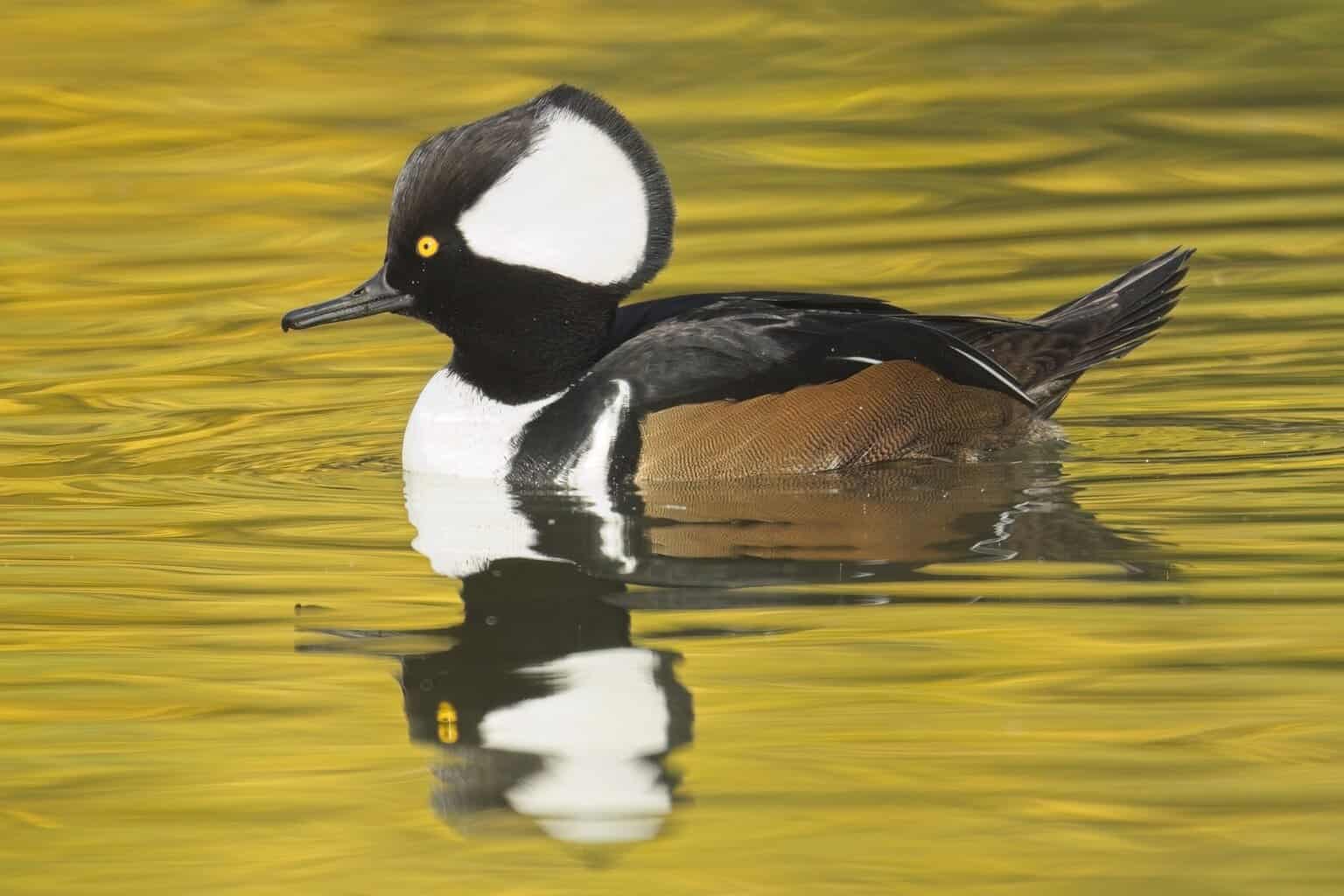
- Scientific Name: Lophodytes cucullatus
- Length: 15.8-19.3 inches
- Weight: 16-31 ounces
- Wingspan: 23.6-25 inches
Hooded Mergansers are also called “frog-ducks,” thanks to the male’s unique breeding call. he sounds like a pickerel frog! Because they are breeding season residents in Minnesota, you may very well hear them before you see them!
They’re also easy to spot when you see them, thanks to their noticeable crest. The male Hooded Merganser has a black and white crest, whereas the female’s crest is reddish-brown. The shape of this duck’s head can change depending on whether its crest is raised or lowered against the head
Hooded Mergansers visit freshwater ponds, rivers, and lakes. When they move south for the winter, they flock to larger bodies of water and show no particular preference between saltwater and freshwater.
Lesser Scaup (Diving Duck)
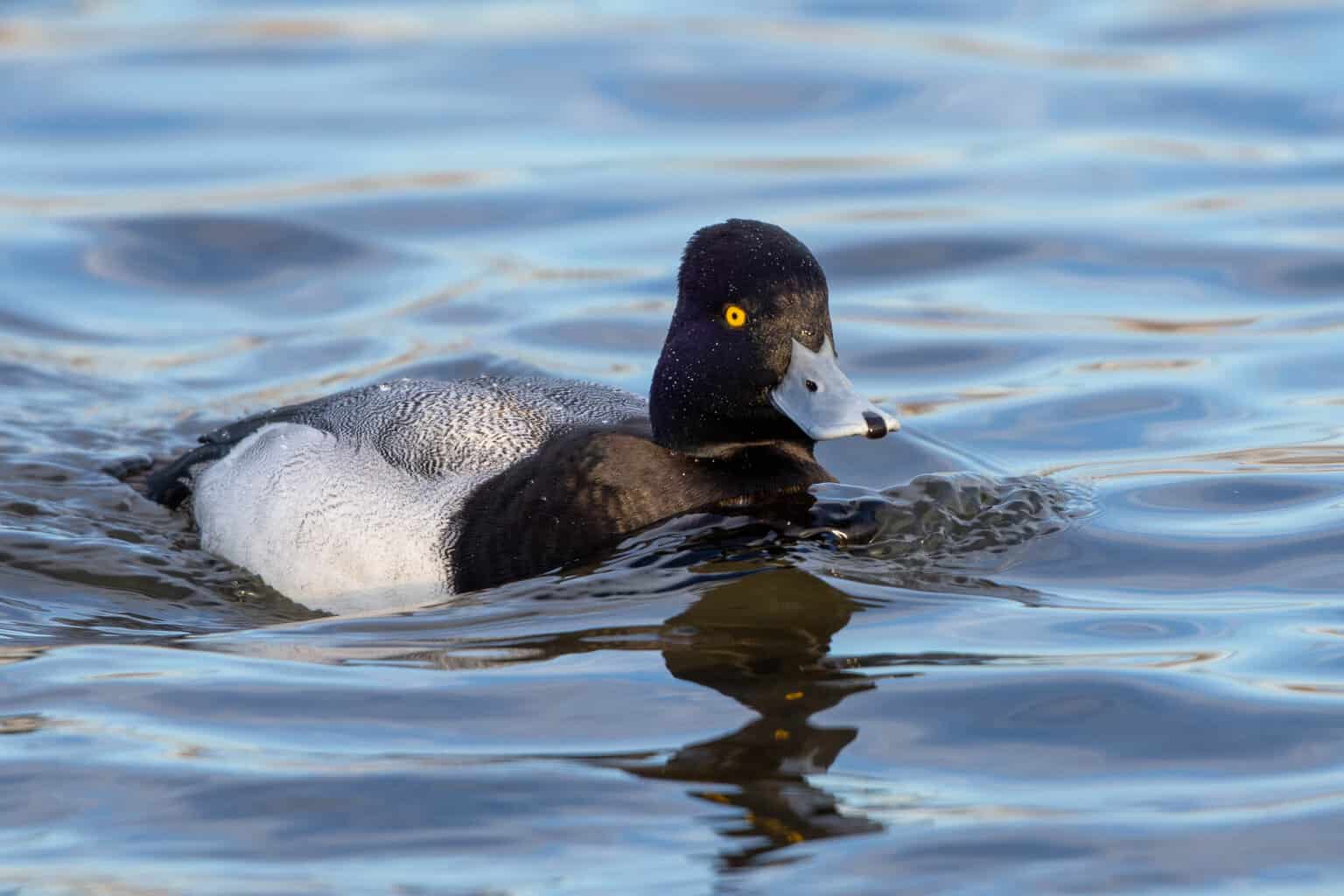
- Scientific Name: Aythya affinis
- Length: 15.3-18.1 inches
- Weight: 16-38.4 ounces
- Wingspan: 26.8-30.7 inches
Lesser Scaups are present in Minnesota during the breeding season, but usually only in the northwestern corner of the state. By late fall, they migrate to the saltwater marshes along the Gulf Coast, including Florida, Louisana, and Texas.
In general, Lesser Scaups are pretty similar to their close relatives, the Greater Scaup. However, the Lesser Scaup has an egg-shaped head and is a bit smaller.
Males are very dark green or purple, with bodies that are mostly white. Females are light brown all over their bodies, with dark brown heads.
There are more than 4 million Lesser Scaups in North America, making them our most abundant diving duck!
Mallard (Dabbling Duck)
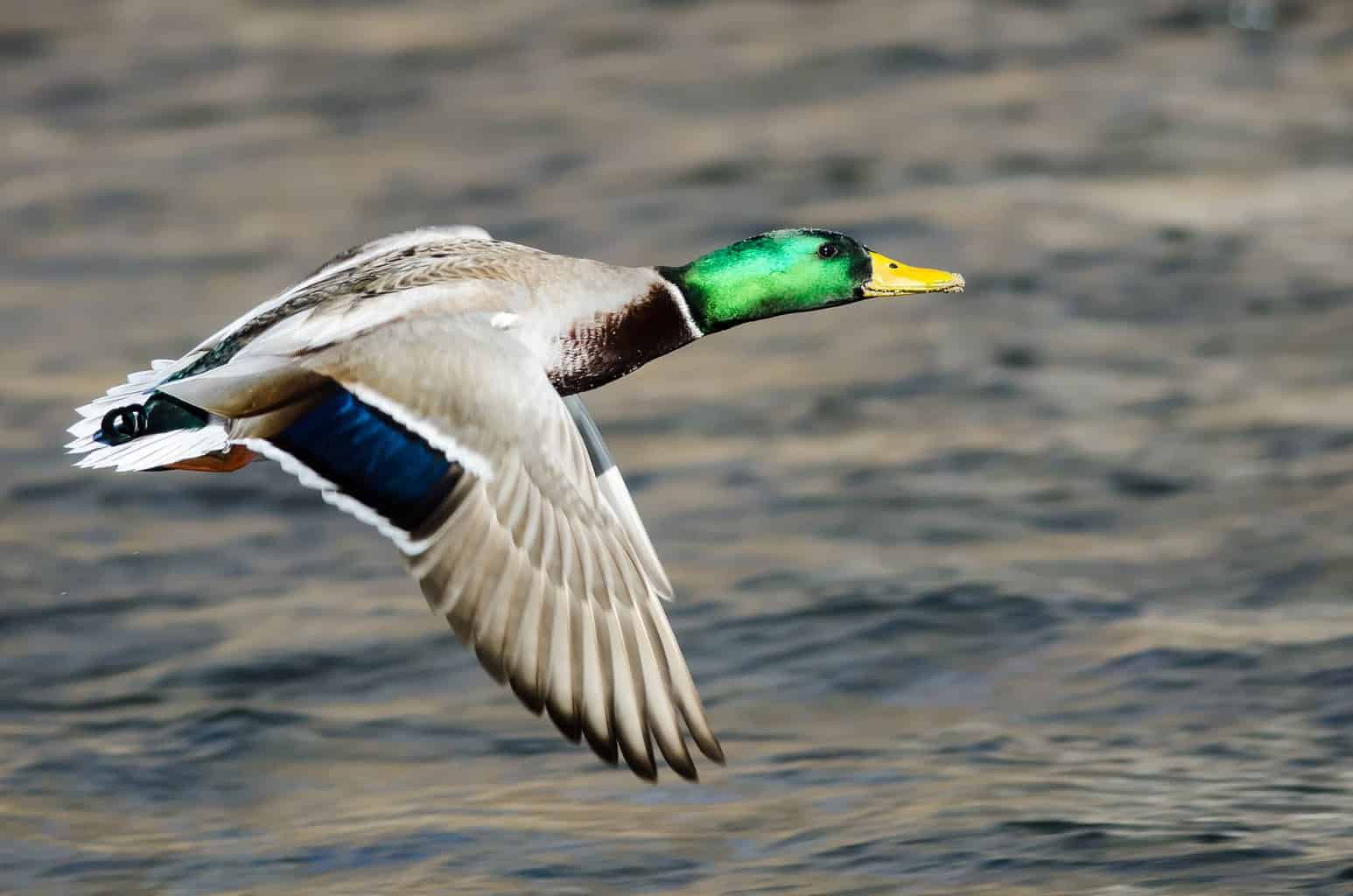
- Scientific Name: Anas platyrhynchos
- Length: 20-26 inches
- Weight: 1.5-3.5 pounds
- Wingspan: 32-39 inches
Is there any duck more iconic than the Mallard? This gorgeous duck lives all over the world, in North America, Europe, Asia, and Africa.
One reason for their widespread distribution is that they can thrive in just about any wetland habitat. They live in marshes, floodplains, reservoirs, city parks, rural farmlands, rivers, ponds, and more. Mallards are not just populous; they are also the common ancestor of almost every domestic breed of duck, thanks to their tendency to interbreed with other ducks.
In Minnesota, they are permanent residents in the southern half of the state, and breeding residents in the north.
During the breeding season, the male Mallard has a stunning metallic green head, a white ring around his neck, a brown breast, a mostly gray body, and a black tail. When he loses his breeding colors, his head stays mostly green, whereas the rest of his body fades to brown.
The female Mallard has streaked brown and light brown feathers over their bodies.
Northern Pintail (Dabbling Duck)
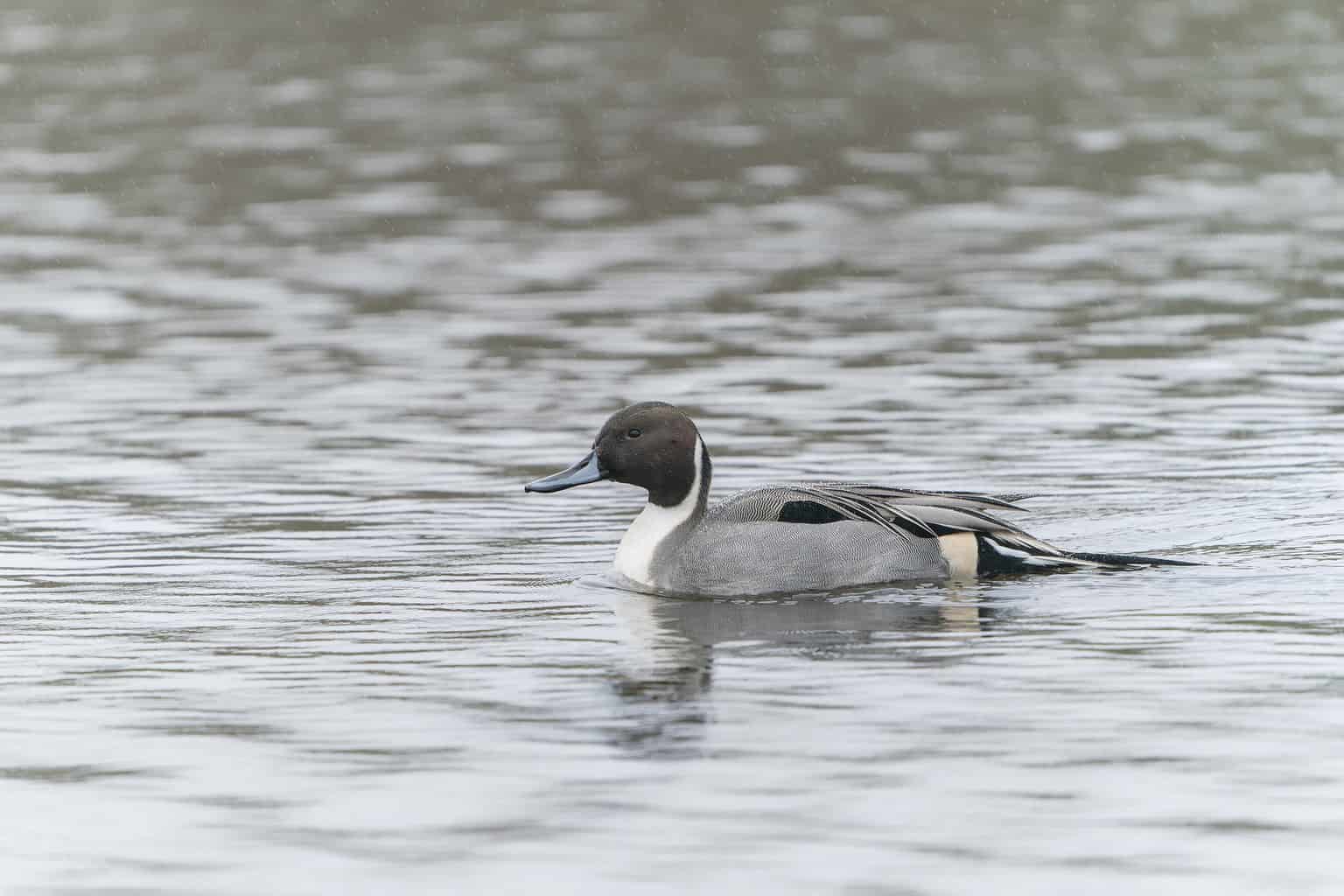
- Scientific Name: Anas acuta
- Length: 20-30 inches
- Weight: 1-3 pounds
- Wingspan: 20-30 inches
Like Mallards, Northern Pintails are prevalent throughout North America and Europe. They are breeding-season residents throughout all of Minnesota, from the northern lakes to the metro region and everywhere else.
They get their name because the breeding male has a long, thin, pointy tail. After the breeding season, they drop these long feathers and look a bit less unique.
The breeding male has a white breast, dark brown neck, and brown head. He has a white line that bisects his head and neck. Year-round, he has a green speculum.
Females are plain, brown, and mostly unmarked except for their iridescent brown speculum.
Northern Shoveler (Dabbling Duck)
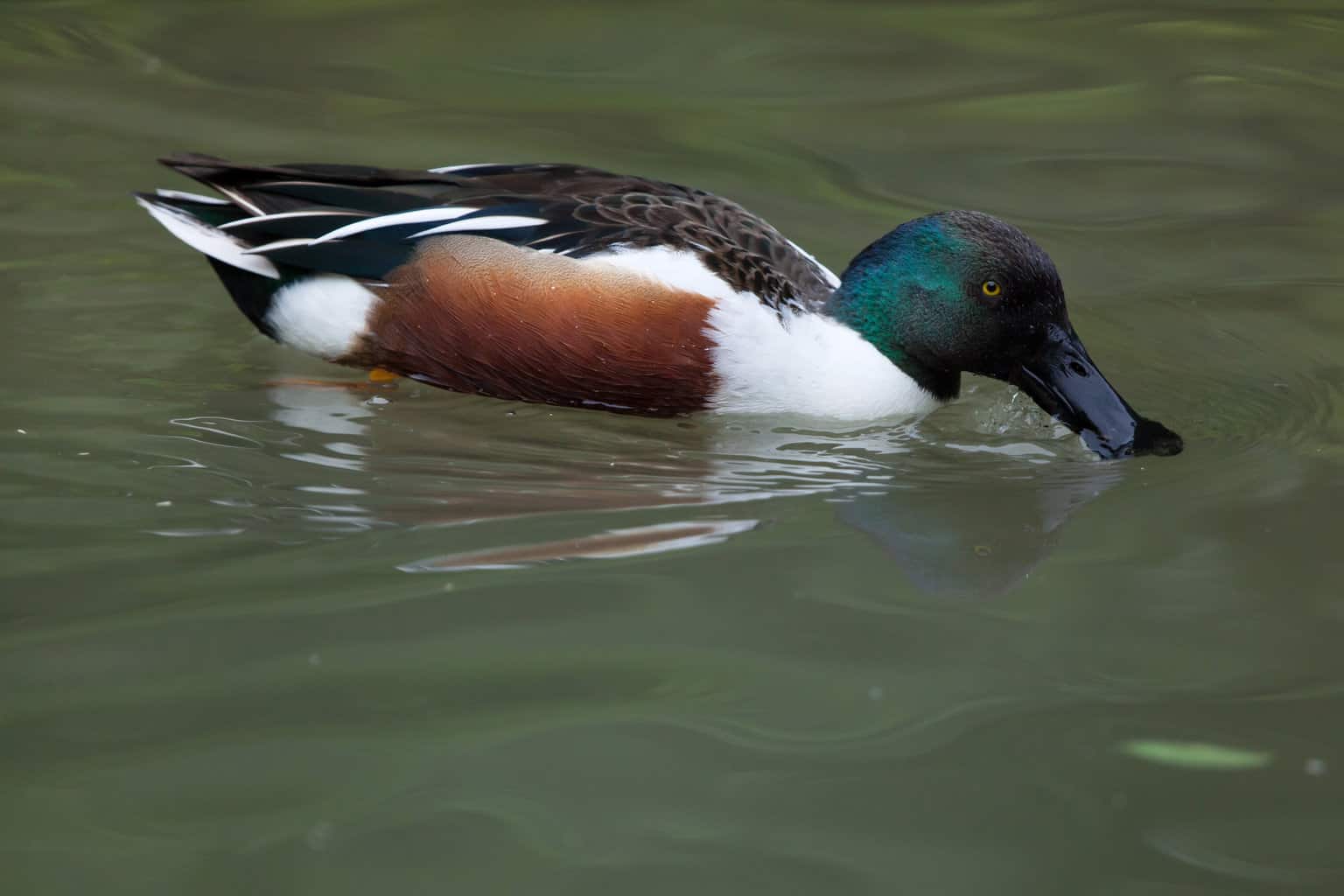
- Scientific Name: Spatula clypeata
- Length: 19 inches
- Weight: 1.3 pounds
- Wingspan: 30 inches
The large, shovel-shaped bill of the Northern Shoveler is unique when compared to other ducks. During the breeding season, Northern Shoveler males are white, green, brown, and light blue with a blue speculum. Males have a dark black bill.
Females, non-breeding males, and juveniles are mottled with cream and dark brown. Females have a bright orange bill.
Northern Shovelers are bolder than other ducks, so they may be easier to approach for identification purposes. They prefer stagnant water, including murky wetlands and agricultural ponds.
They nest in tall grasses, so they are effectively camouflaged when nesting. On the water, watch for that big, broad bill!
Northern Shovelers have an interesting – but pretty gross – method for protecting their nests. When a female is startled and has to flee the nest, she will defecate all over the nest and the eggs in order to make them less appealing to predators.
These ducks are not extremely common in Minnesota, but there are usually some spotted in the state every year, especially during the breeding season.
Red-Breasted Merganser (Diving Duck)
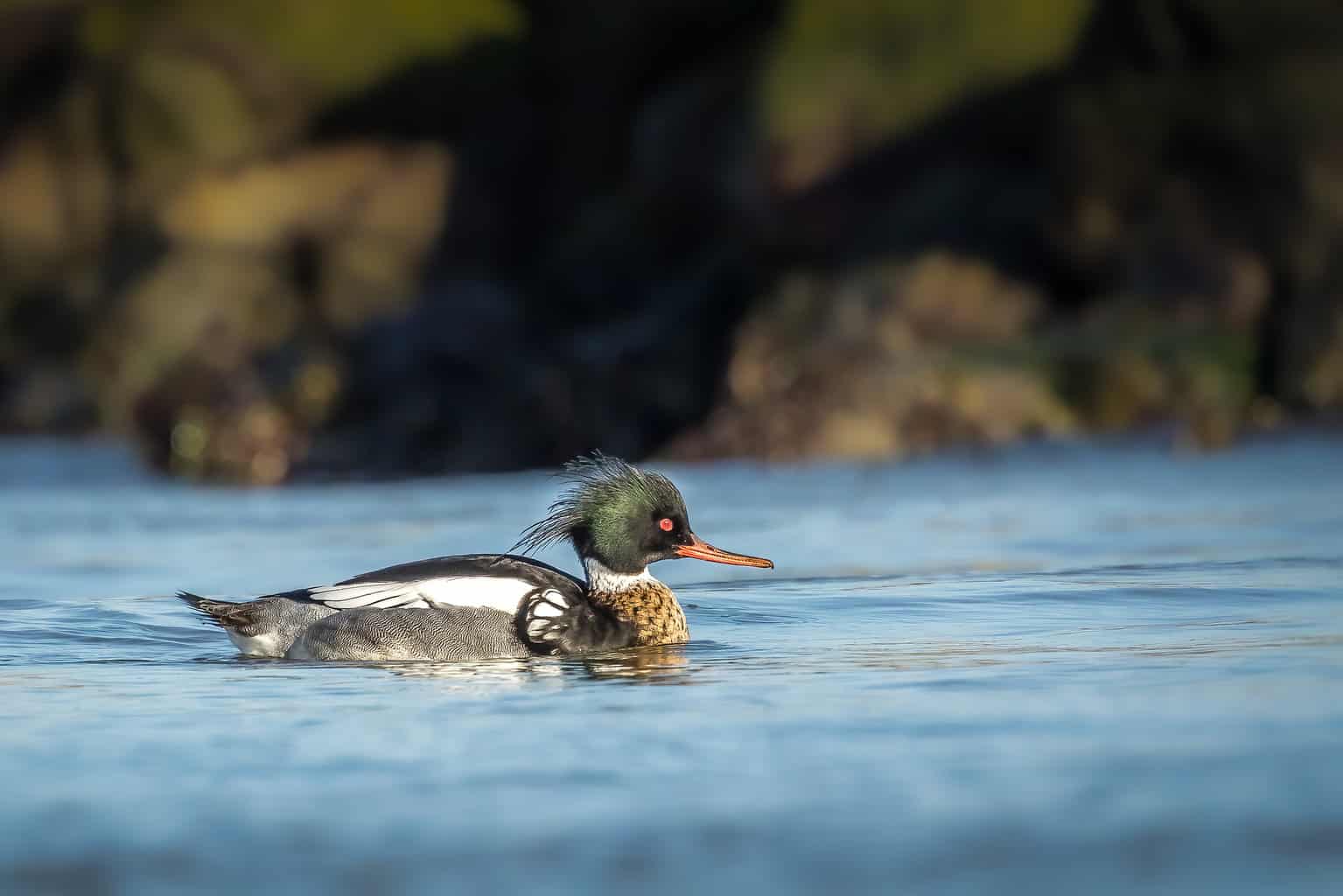
- Scientific Name: Mergus serrator
- Length: 20-24 inches
- Weight: 2.3 pounds
- Wingspan: 28-34 inches
Red-Breasted Mergansers have long, shaggy feathers on their heads – giving them a totally different silhouette from many other ducks on this list.
Males have a greenish-black head, whereas females have a light brown head. The male’s chest is cinnamon-brown, and he has a thick white band around his neck. Females don’t have the white band, and their coloring is primarily gray.
Red-Breasted Mergansers gather in huge flocks during the winter. Their winter territory is limited to the coastal edges of the US, including the Atlantic, Pacific, and Gulf of Mexico.
They migrate through the rest of the country and spend the winter in Canada. In Minnesota, you can find them during the breeding season along the coast of Lake Superior. They have a strong preference for seawater.
Redhead (Diving Duck)
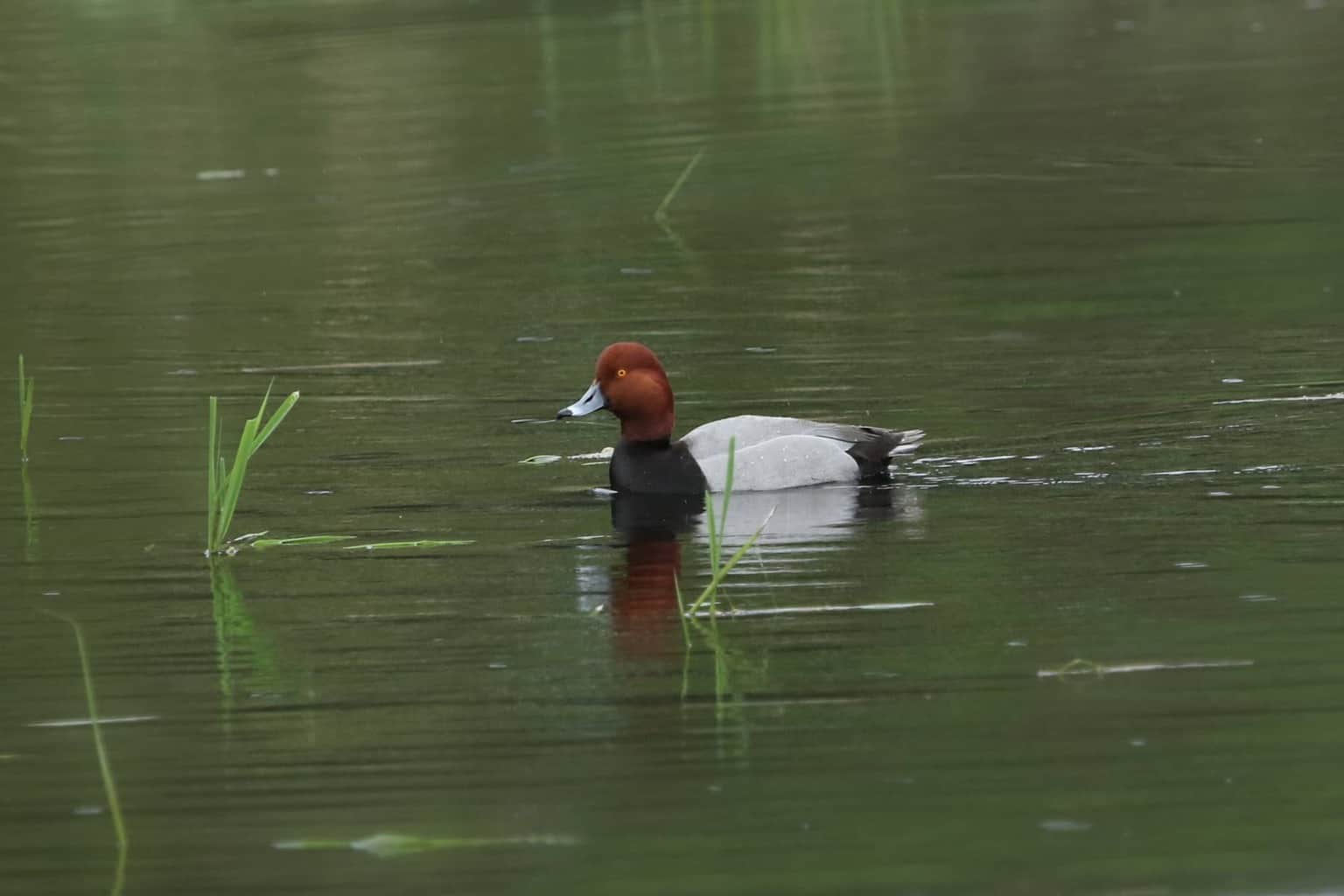
- Scientific Name: Aythya americana
- Length: 18-22 inches
- Weight: 2-2.5 pounds
- Wingspan: 33 inches
To identify the male Redhead Duck, look for his very dark brown head and black breast. The sharp contrast between his head and breast makes him easy to spot, even for children or new birders.
Female Redheads are more muted, with minimal markings. Their bodies are light brown.
Males and females alike share two traits: gray flight feathers and rounded heads.
Redhead Ducks prefer deep water and dense grasses for nesting. They like slow-moving rivers and large lakes that are bordered by tall grasses. In Minnesota, Redheads are late-fall migrants who sometimes spend the whole winter in large lakes.
They are most likely to be found in the southeastern region of the state, especially along the Mississippi River.
Ruddy Duck (Diving Duck)
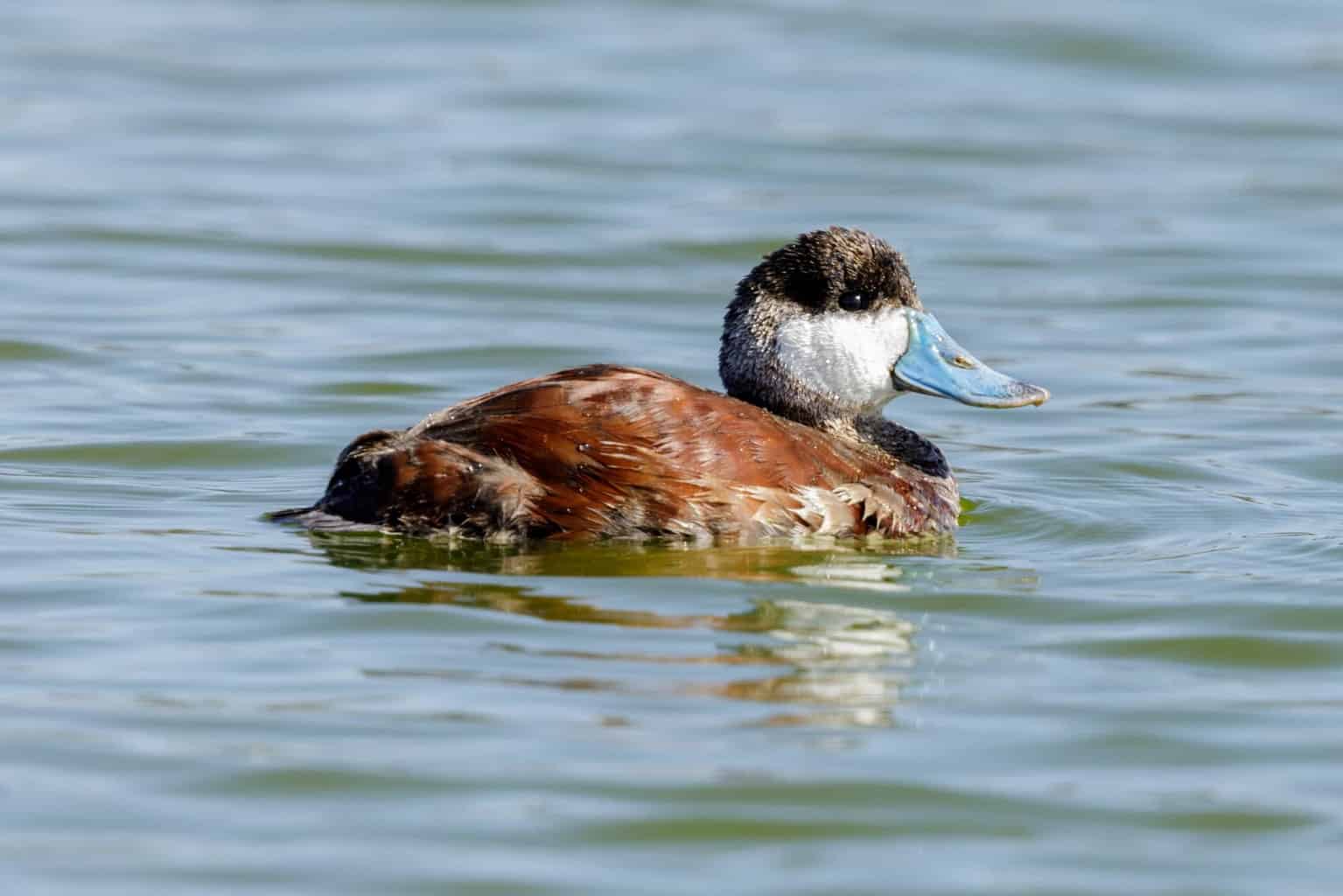
- Scientific Name: Oxyura jamaicensis
- Length: 13.5-17 inches
- Weight: 1.23 pounds
- Wingspan: 18.5 inches
During the summer, breeding male Ruddy Ducks are identifiable by their bright blue bills. Minnesotans will only see this blue bill in the western part of the state, though, as their breeding territory ends at the edge of Minnesota.
Otherwise, you may see non-breeding males and females in the rest of the state during the spring and fall migration periods.
Non-breeding males have a black bill and a dark black head with a big white cheek patch. Females are light brown, but they have dark crowns. Ruddy Ducks use their thick tail as a rudder in the water.
If Ruddy Ducks are known for something, it’s how aggressive they are! Ruddy ducks will chase and attack other duck species – as well as each other!
They will even chase away rabbits who come too close to their nests. Sometimes it seems like Ruddy Ducks are not afraid of anything!
Wood Duck (Dabbling Duck)
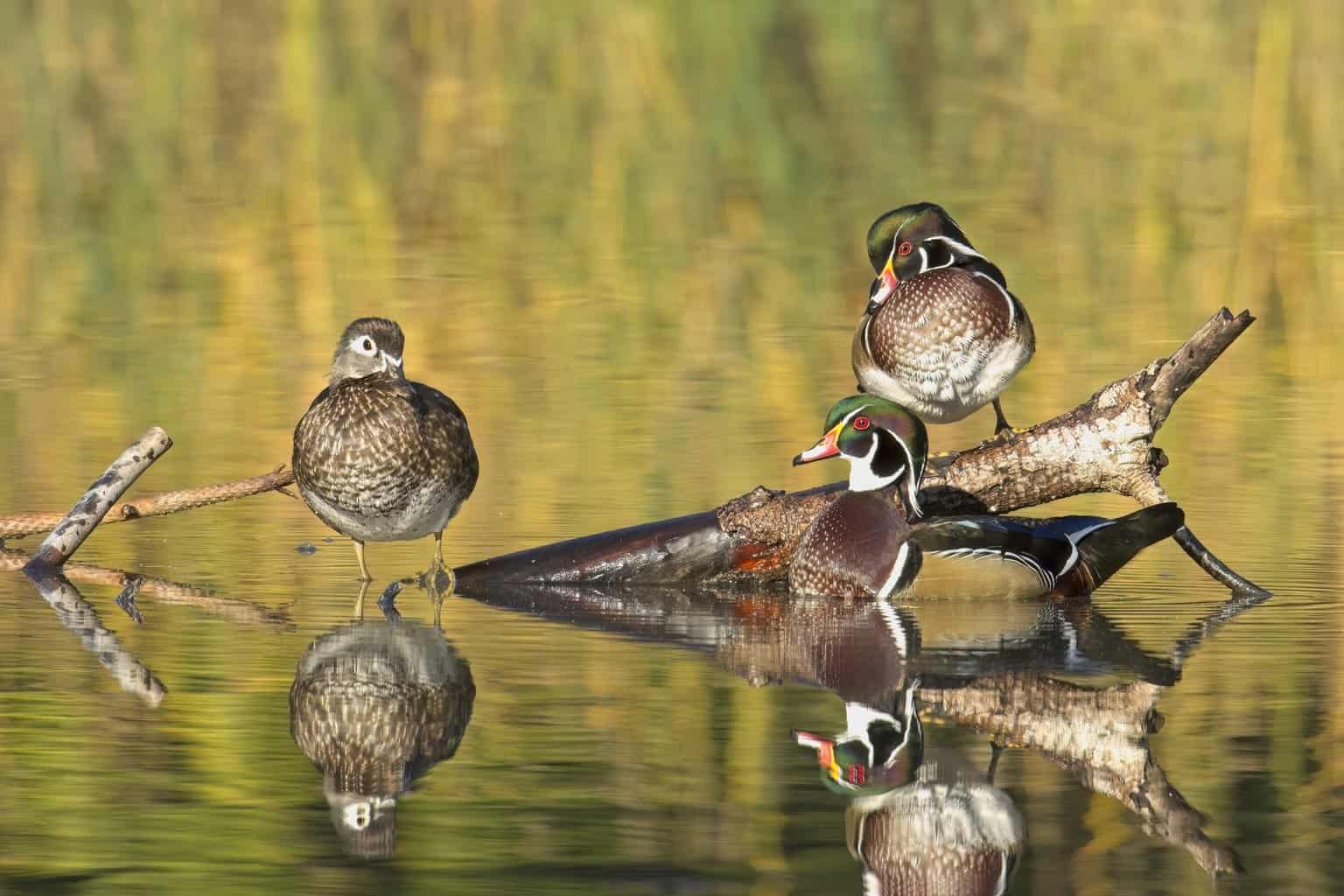
- Scientific Name: Aix sponsa
- Length: 17-20 inches
- Weight: 1.5 pounds
- Wingspan: 28 inches
Talk about an easily recognizable duck! Male Wood Ducks have vibrant, iridescent green heads that are lined with white. His regal appearance includes a chestnut-brown breast that has white spots all over it.
Like many other sexually dimorphic duck species, females look very different. Their bodies are brownish-gray and they lack the distinct patterns that make the male stand out.
After the breeding season, males lose most of their regal coloring but maintain a multi-colored bill all year.
Wood Ducks are cavity dwellers. They nest in empty tree cavities left by other animals and birds, and they live alongside freshwater swamps, rivers, and marshes. They are especially likely to be spotted where there are plenty of cattails for protection and camouflage!
Wood Ducks live in southern Minnesota year-round. In the north, they are breeding-season residents only.
The Final Word on Ducks in Minnesota
This list should be compelling evidence that Minnesota’s abundant lakes, rivers, and wetlands make it an incredible place for ducks!
And, of course, that’s not all! Minnesota’s residents and visitors can also find other amazing birds in the state, including redbirds, birds of prey, finches, sparrows, tanagers, herons, and so many more!
If you live in Minnesota, you are lucky to live in a place with so many incredible birds. And if you are visiting for any reason, whether for vacation, business, or to visit friends and family, take advantage of the plentiful wildlife while you’re here and find some incredible birds.

